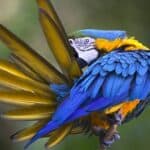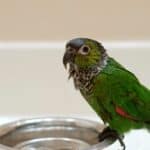Last Updated on January 28, 2024 by Carrie Stephens
Puffing up makes a parrot look bigger, which is achieved by vibrating or shaking their skin.
This spreads individual feathers apart, making them stand up straight. Puffiness can happen suddenly and be accompanied by a full-bodied tremor.
Parrots fluff their feathers to preen, regulate temperature, and show happiness.
They may also puff up their feathers to avoid showing weakness when ill. Fluffed feathers are paired with growling, eye-pinning, and sinking lower when due to defensive behavior.
If a parrot is happy to see you, it’ll puff up its feathers and shake its tail. When cold, it’ll squat to conserve warmth. However, it’ll lift its feathers to promote airflow when it’s too hot.
Why Parrots Fluff Their Feathers
All parrots fluff up their feathers. It’s a natural response that enables them to:
Display Aggression
Parrots fluff their feathers when feeling threatened, making them appear larger and more intimidating.
Cockatoos and cockatiels often exhibit annoyance by puffing up. The crest on their heads will also rise prominently, increasing their height.
There are many types of aggression, including:
- Direct: This is directed at individuals or objects threatening or annoying the parrot.
- Indirect: This is directed at a secondary individual not involved with threatening or angering the parrot. Indirect aggression is displayed toward weaker creatures, like a smaller cage mate.
- Active: This usually results in a parrot harming other people or a cage mate.
- Passive: This is characterized by actions that may not appear overtly aggressive, like a refusal to follow commands or nurture its young.

Showing Affection
Parrots fluff their feathers when excited or feeling affectionate. With a close bond, you’ll see the parrot shaking its feathers to appear puffier upon entering the room.
Although a parrot may flap its wings, it doesn’t hold them up to continuously appear larger. When you get closer, the parrot should lay its feathers down and be receptive to your touch.
Preening
According to the Philosophical Transactions of the Royal Society, parrots preen to remove parasites, dirt, and debris. They also apply preen oil while aligning their feathers.
Since the feathers lay flat against the parrot’s body, it’ll lift them to gain better access. This also enables the parrot to clean the secondary feathers next to the body.
Adjusting To Temperatures
A parrot’s feathers provide a thick layer of insulation. They’re unique because they can puff up to trap air pockets. Body heat warms the air, which is beneficial in colder environments.
Feathers promote airflow. When overheating, a parrot can’t sweat. Instead, it dispels heat through the skin. It exchanges heat by lifting its feathers and letting cool air pass over the body.
Parrots lift their wings, fluff their feathers, and hold this position as they cool down.
Concealing Illnesses
Parrots hide their injuries and illnesses to avoid the attention of predatory animals. To create a façade, a parrot will seek to appear at its strongest when at its weakest.
What It Means When A Parrot Fluffs Its Feathers
You may confuse aggressive fluffing as a sign of affection. You may also think the parrot is temperature-sensitive when it’s ill. Here are some ways to narrow down the meaning:
Aggressive Fluffing vs. Affection Fluffing
Parrots often react positively to their favorite humans upon entering the room.
If the parrot displays aggression-related fluffing, you’ll notice the following:
- Feathers raised away from the body.
- Head feathers partially raised.
- Eye pinning.
- Body low to the ground.
- Growling or hissing.
Owners should familiarize themselves with the growling sound, which is a giveaway that the parrot feels threatened by something or someone in the surrounding area.
Affection-related fluffing is usually characterized by the following:
- Tail wagging.
- Singing.
- Friendly vocalizations, like chirping.
Cold vs. Sick Parrot
It can be hard to tell when the parrot is cold or sick based on its fluffing behavior alone. A parrot that feels cold and wants to warm up will:
- Bury its beak into its chest feathers.
- Fluff up its feathers across its body.
- Squat to cover its bare legs with feathers.
A sick parrot will display other signs:
- A more disheveled appearance from being too weak to preen.
- Changes in appetite or the amount of water it’s drinking.
- Difficulty balancing on its perch.
Fluffed Feathers And Cleanliness
Bathing softens the dirt on the feathers, making them easier to preen. If a parrot goes too long without bathing, it’ll have difficulty removing dirt and grease, leading to more vigorous preening.

Parrot Fluffing Due to Stress
Parrots may fluff up or shake when stressed or anxious, making them look larger, safer, and warmer. Additionally, stress can manifest as the following:
- Aggression toward cage mates.
- Feather destructive behavior.
- Biting the skin.
If the parrot is stressed, you must narrow down the cause.
Unsuitable Cage Mate
Parrots can grow upset when housed with other birds they dislike.
This stress could be tied to the fear and intimidation they experience from being around a bigger, stronger parrot. A parrot may also dislike sharing its living space with other birds.
New Setting
Pet parrots grow to like a particular room if they have lived there long enough. Moving them to a new setting takes them out of their comfort zone and causes stress.
Background Noise
Some parrots dislike noise because they need up to 12 hours of sleep.
External noises can disturb naps and cause them to behave erratically. Moving the cage to a quieter room can be beneficial, but changing the setting can be stressful.
Light Exposure
Parrots are sensitive to light and adapt their lifestyles based on sunlight. This means they’re active during daylight hours and sleep at night.
However, exposure to artificial lighting at night can keep a parrot awake. According to Scientific Reports, many bird species have difficulty sleeping due to light pollution.
If the cage is kept in a room with artificial lighting, it may grow stressed and puff up its feathers in frustration. An easy workaround is to cover the cage at night.





